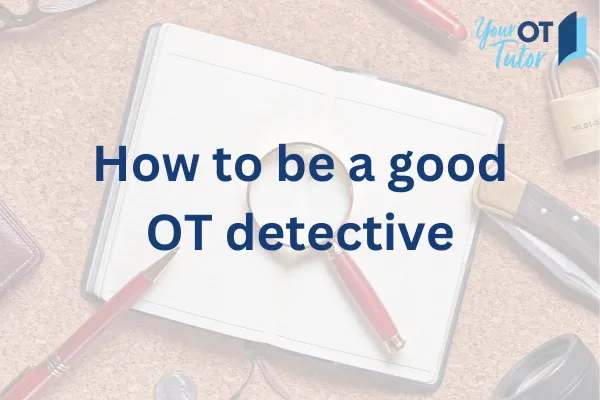THE YOUR OT TUTOR BLOG
Articles on important topics for occupational therapists...


How to be a good OT detective
I’ve been noticing a common problem for occupational therapists. In the chaos of funding systems like the NDIS, we can fall into the trap of trying to find a solution as quickly as possible. But in the process, we may be skipping through a crucial part of the OT process – the information gathering. By not taking the time to fully understand what may be contributing to the functional difficulties our clients are experiencing, we start to doubt our clinical reasoning. Our reports lack strength when it comes to providing evidence. And we find out down the track that those recommendations we made didn’t actually work.
So how can you do better? Here’s four ways you can improve your OT detective skills, with a practical example to show you exactly what I mean.
1. Use an OT model to guide your interview questions
As an OT student we are introduced to OT models like the PEO, MOHO and Kawa. But then we go out on placement and we rarely see our supervisors using them in practice. Most of the time it’s because experienced OTs have already developed the ability to ‘think like an OT’ without necessarily having an OT model in front of them. But if you’re an OT student or new grad, or even an experienced OT tackling a complex client scenario, sketching a model out on paper can help.
Imagine you’ve received a referral to see Jane, a 53-year-old with Multiple Sclerosis who is struggling to get a good night’s sleep. There’s so many factors that could be contributing to making sleep difficult for Jane, but where do you start, and how do you make sure you don’t miss anything? In this case using a model like the PEO could help us to ask Jane the right questions to uncover all the reasons why sleep may be difficult.
- The P (Person) reminds us to consider a range of person factors. Are physical symptoms like spasticity or restless legs causing discomfort when in bed? Is her decreased mobility preventing her from easily readjusting her position in bed to find a position of comfort? Are psychological symptoms like ruminating thoughts or anxiety about her loss of function stopping her from being able to switch off and fall asleep?
- The E (Environment) reminds us to ask Jane about her environment (and of course take a look ourselves). What is the temperature like at night – too hot, too cold, can she adjust the temperature? How quiet or noisy is it, and what does she prefer to help her stay asleep? She leaves a light on in case she needs to get up during the night, but how bright does it make the room as a result?
- The O (Occupation) reminds us to ask about what she would like sleep to look like. How many hours is ideal? Does she want to sleep alongside her husband or separately? What does her daily routine look like in the lead up to sleep, and how might that be making an impact?
-
The model has reminded us to look beyond what might seem like the obvious answer and consider everything else we should be addressing to. It reminds us to not just trial a new bed, but to chat with her medical team about optimising her medications to ensure symptoms are optimally controlled, or to refer her to a psychologist to ensure her anxiety is being addressed, or to help her find small changes to her routine that may optimise her body for sleep. It reminds us to take a holistic approach to our clinical reasoning.
2. Use standardised assessments to take a systematic approach
When it comes to something like prescribing assistive technology, I’ve heard experienced OTs say, “I don’t use standardised assessments; I know what I’m looking for during the functional assessment and what works.” Great, but what if you’re not at that level yet and you need to know what you should be looking at or asking about?
In this example you’ve just received a referral to prescribe Bill, an 82-year-old, a new mobility scooter. Do you go straight to the equipment showroom and get him to test drive his favourite, or do you consider a few more things first?
For this situation, a comprehensive standardised assessment like the Powered Mobility Device Assessment Training Tool (PoMoDATT) can help you learn what goes into doing a comprehensive assessment for a mobility device like a scooter.
It reminds you to not just consider physical abilities, but Bill’s cognition too. It gives you some scenarios you could ask Bill to test how he might react in tricky situations like “What would you do if you broke down?” And when you’ve watched him do a few laps up and down the street and are wondering “What else should I be checking?” it gives you a whole checklist of suggestions and a rating scale to allow you to judge more than just whether it looked good or bad.
The quality of your assessment will be improved, and you’ll feel more confident that you’re not missing anything, because you’ve taken a systematic approach provided by the standardised assessment tool.
3. Analyse the activity with your own eyes!
When it comes to understanding the full picture, being able to complete our own observations and see our client’s performing tasks with our own eyes can make all the difference. It’s important that we speak to our clients and hear their perspective, but we can’t feel confident that we’ve found the right solution until we see what’s going wrong in the first place.
In this example your new referral is for Jemma, an 18-year-old with physical and intellectual impairments associated with her cerebral palsy. Her carers usually provide 1x assist with her toilet transfers, but she’s getting too big and heavy and they think it’s time for some sort of hoist.
Now you could jump to booking in some equipment trials for your first visit, or you could start by observing what’s currently happening first. That observation may reveal that her carers are providing a lot of physical effort in the transfer, but they’re not trying to prompt Jemma to help with the movements in anyway. They’re not demonstrating what they’d like her to do, or giving her time to think about the next step before rushing along and just doing it for her.
In this instance the solution may not be a hoist at all, but some more practice to see exactly how much Jemma can participate in the transfer with the right instructions and time. A hoist would be a Band-Aid solution when we really need to go back a step and help Jemma build her capacity to participate more in transfers, and this includes providing education for her carers about how they can continue to do this when we’re not there.
The time taken to do some observations and analyse exactly what Jemma’s abilities were and how they could be facilitated during the specific task could save not only the cost of a hoist, but also allow Jemma to increase her dignity and participation at the same time.
4. Allow your client to share their perspective
Some clients will expect us to have all the answers. To do an assessment and tell them the ‘right’ answer for what to do. But what if on paper there are multiple potential ‘right’ answers, and the client’s preferences are the deciding factor for what will be the winning answer?
For the final scenario you’re an OT working with Beth, a 30-year-old with schizophrenia. She experiences challenges with her executive functioning and is unable to reliably prepare meals for herself each day. You’ve done a meal prep assessment and can see reduced attention and memory, and difficulty multi-tasking, resulting in mental exhaustion by the end of a task like cooking some eggs on toast.
You’re now writing up your recommendations in your NDIS Functional Capacity Assessment and you go with the default of requesting increased support worker hours to help with meal preparation. It gets funded (yay!) but when you check in a few months later Beth is still not having meals consistently. She hasn’t booked in a support worker to help with dinner like you recommended. She was feeling overwhelmed having someone in her home every day, and in the end told them to stop coming.
In this case the missing step of your information gathering was that you didn’t involve your client in identifying the right solution. What other solutions could have been appropriate? You could have discussed options like ready-made meals, or AT like a Thermomix, to allow her to still complete cooking independently, but with a reduced cognitive load. Taking this time would have ensured that your recommendations actually worked for Beth.
Hopefully this has been a good reminder to go deeper with your OT detective work. To go back to your foundational skills of thinking like an OT and engaging in collaborative, client-centred practice, to find the best solution. And just remember…
Don’t underestimate the value of good OT detective work to determine the reason behind your client’s functional difficulties – your reasoning will be clearer, your reports will be better, and your recommendations will actually work.
P.S. If these examples have inspired you to go back to your own foundations of OT success, why not check out the Your OT Tutor Alliance or Your OT Tutor Connector CPD programs. You’ll learn practical tips on core OT knowledge and skills that will help you become a better OT who loves what you do. If you found this newsletter helpful, make sure you check out the Your OT Tutor website and subscribe to the mailing list or sign-up for the Learning Library – there are heaps of FREE resources, courses, and CPD opportunities, with more being added regularly.
#OccupationalTherapy #NDIS #YourOTTutor






